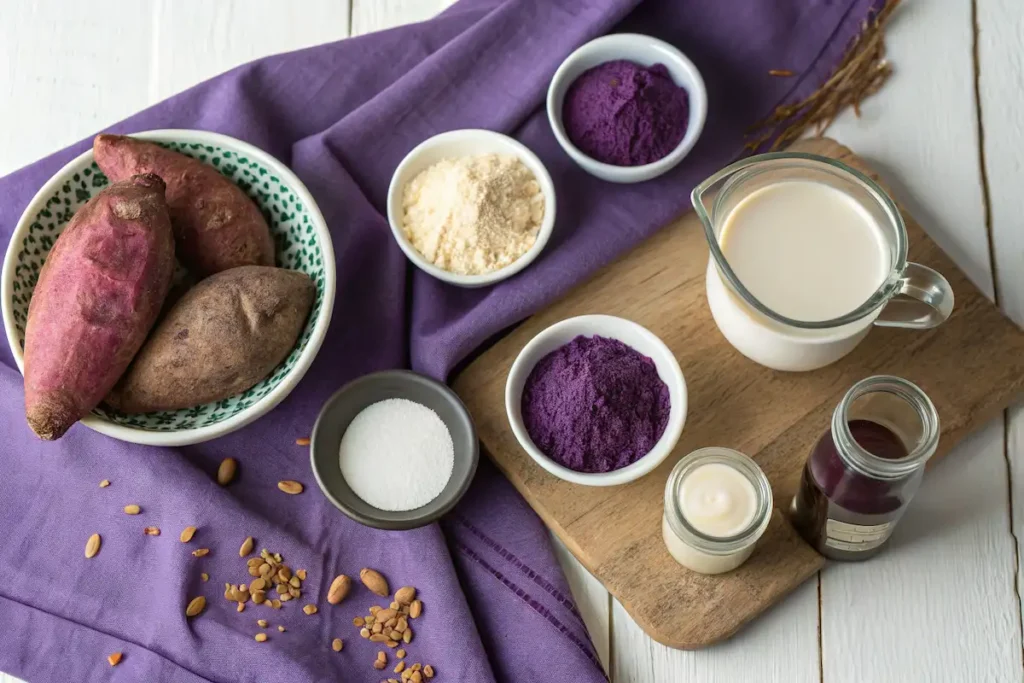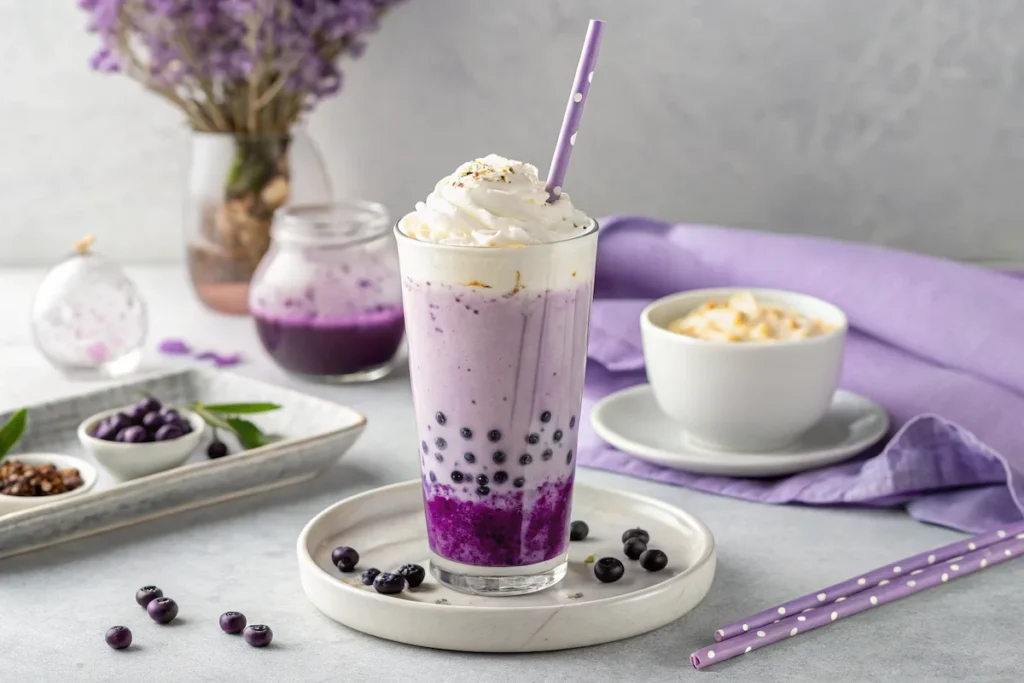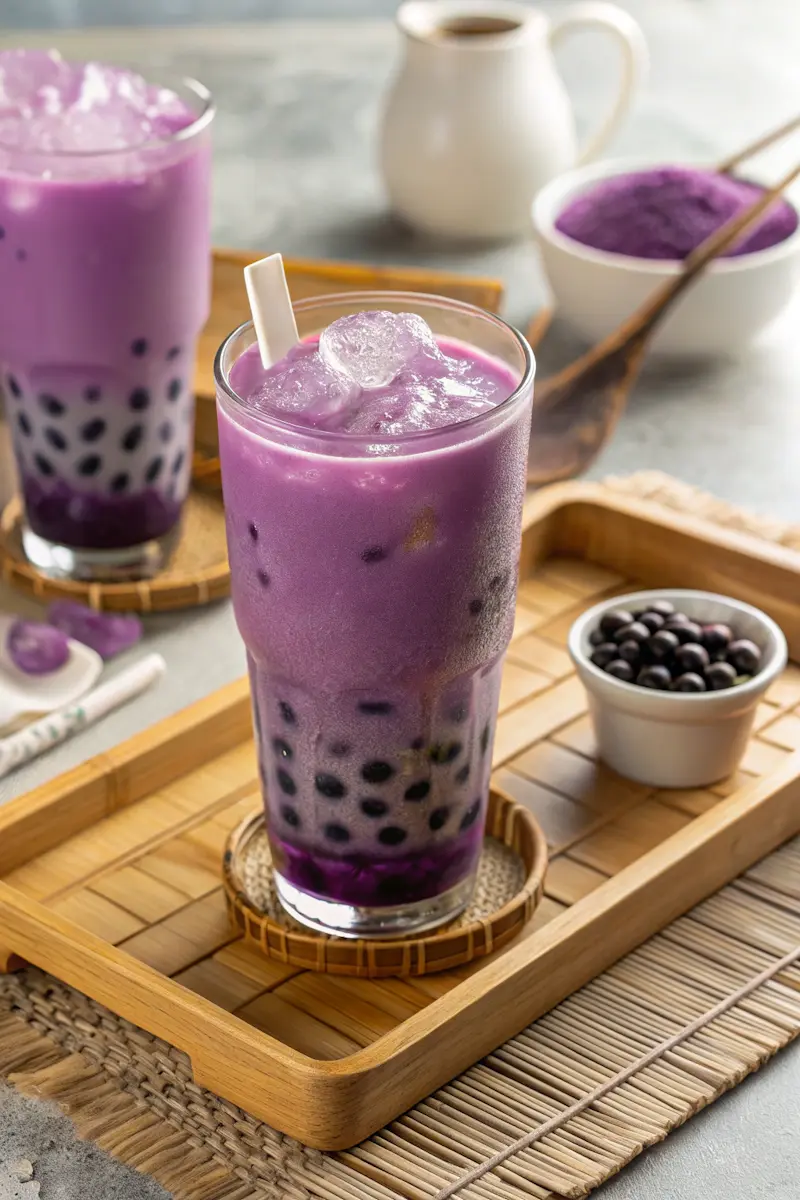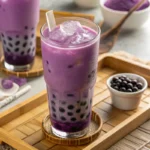Ube milk tea isn’t just a pretty drink—it’s a cozy moment in a glass. You know those days when you need something sweet, something colorful, something that reminds you there’s beauty even in the busiest moments? That’s what this tea feels like to me.
Made with purple yam—ube, as we call it in the Philippines—it’s naturally vibrant and comforting. I first tried it on a whim after a long teaching day, and now it’s one of my favorite ways to unwind. Creamy, a little vanilla-like, and absolutely gorgeous to look at, this is the kind of drink that impresses without trying too hard.
In this post, I’ll show you exactly how to make ube milk tea the easy way, with a few options depending on what’s in your kitchen. I’ll also clear up the taro confusion (yes, they’re different!) and show you how to make it dairy-free, loaded with boba, or turned into a dreamy iced latte. Let’s get into it—you’re going to love this.
Table of Contents
The Royal Hue: Crafting Your Own Ube Milk Tea
Ube milk tea is a vibrant Filipino drink made with purple yam, offering a rich, creamy flavor and stunning color. This sweet, dessert-like beverage can be prepared with fresh ube, powder, or extract, and customized with boba, cream, or coconut milk for the perfect tropical twist.
- Prep Time: 10 minutes
- Cook Time: 15 minutes
- Total Time: 25 minutes
- Yield: 2 servings 1x
- Category: Drink
- Method: Blended
- Cuisine: Filipino
Ingredients
- 1 cup fresh ube (steamed and mashed) or 1 tbsp ube powder or 1 tsp ube extract
- 1 cup whole milk (or oat/coconut milk)
- 2 tbsp condensed milk or 1–2 tsp sweetener
- Optional: ½ cup brewed jasmine or white tea
- Ice or hot water (depending on serving style)
Instructions
- Peel, steam, and mash fresh ube (or prepare ube powder/extract).
- Optional: Brew jasmine or white tea and let it cool.
- Blend mashed ube with 2–3 tbsp milk and sweetener until smooth.
- Mix in remaining milk and brewed tea (if using), then blend again.
- Serve over ice or gently heat for a hot version.
- Optional: Add boba, coconut cream, or whipped topping.
Notes
For the creamiest texture, use whole or full-fat milk options and a high-speed blender. Adjust sweetness to taste based on your ube product. Ideal for serving in clear glasses to showcase its vibrant purple hue.
Nutrition
- Serving Size: 1 cup
- Calories: 180
- Sugar: 12g
- Sodium: 65mg
- Fat: 6g
- Saturated Fat: 4g
- Unsaturated Fat: 2g
- Trans Fat: 0g
- Carbohydrates: 28g
- Fiber: 1g
- Protein: 4g
- Cholesterol: 15mg
Understanding Ube: The Jewel of the Philippines
What is Ube? A Sweet Purple Yam
Ube (pronounced “oo-beh”) is a vibrant purple yam native to the Philippines and widely loved across Southeast Asia. It’s not just a root vegetable—it’s a cultural icon. Known botanically as Dioscorea alata, ube plays a central role in Filipino cuisine, especially in sweets and celebratory desserts.
The flavor of ube is what sets it apart. Naturally sweet with notes often compared to vanilla, white chocolate, and even pistachio, ube offers a complex yet comforting profile. When cooked, its dense texture becomes soft and mashable, perfect for recipes like ube halaya, a thick, jam-like dessert that often serves as a base for other treats—including ube milk tea.
One of ube’s defining features is its color: a deep, jewel-toned purple that holds its intensity even when cooked. This natural vibrancy makes it a visual standout, especially in drinks. Unlike artificial colorings or diluted root vegetables, ube shines with authenticity and appeal.
Traditionally, ube has been used in cakes, pastries, halo-halo, and ice cream. Its transition into milk tea reflects both its versatility and the growing global love for Filipino flavors. In fact, Filipino ube desserts are quickly becoming sought-after worldwide, with ube milk tea leading the wave.
Ube vs. Taro: Clarifying the Purple Confusion
Though often confused because of their similar appearances in drinks, ube and taro are distinct in every way. Ube is a yam with a naturally intense purple color, sweet and vanilla-like in flavor, and hailing from Filipino cuisine.
Taro, by contrast, is a corm with a pale grayish or whitish flesh flecked with purple. It requires added coloring to achieve a vibrant hue in milk teas. Its flavor is nuttier, more earthy, and far less sweet.
Understanding this difference helps avoid mix-ups and gives ube the spotlight it deserves. (For a deeper dive into its often-confused cousin, see our guide on Taro Milk Tea.)
Forms of Ube for Milk Tea
Ube comes in several forms for milk tea use:
- Fresh Ube: Best for authentic taste. Requires peeling, steaming, and mashing.
- Ube Powder: Convenient and often vibrant; just rehydrate and mix.
- Ube Extract/Flavoring: Quickest option but may include artificial additives.
Choose based on convenience, availability, and how natural you want your drink to be.
The Benefits of the Purple Yam
Beyond its beauty and flavor, ube delivers real nutritional perks—especially when fresh. It’s rich in complex carbohydrates, vitamin C, B6, and minerals like potassium and manganese.
The deep purple pigment? That’s from anthocyanins, powerful antioxidants linked to reduced inflammation and improved heart health. Ube’s dietary fiber also supports digestion. Just remember: these benefits drop off in processed powders or flavored syrups, so fresh or minimally processed options are best.
The Creamy Base & Sweetness: Perfecting the Blend
Selecting the Ideal Milk
To bring out the richness of ube milk tea, the choice of milk matters. Whole milk is ideal for creating a velvety texture that complements ube’s natural sweetness. If you’re going dairy-free, opt for barista-grade oat milk for its smooth finish or coconut milk to echo ube’s tropical roots.
The goal is simple: pick a milk that lets the purple yam flavor shine through without watering it down. Light plant-based milks may not offer the body needed for that thick, dessert-like mouthfeel. Go for full-fat options whenever possible.
Sweetening to Ube Perfection
Ube is naturally sweet, but to elevate it in tea form, just the right sweetener helps. Condensed milk is often used in Filipino ube desserts and adds creamy richness. Simple syrup or brown sugar bring out subtle caramel notes, while white sugar works for clean, direct sweetness.
Start small—especially if your ube powder or extract is pre-sweetened. Taste and adjust gradually. (For those watching sugar intake, check out our guide on No-Sugar Options for Milk Tea—but remember, ube’s charm is its gentle sweetness.)
Crafting Your Royal Brew: Recipes for Ube Milk Tea
Authentic Fresh Ube Milk Tea Recipe
Want the most authentic flavor? Start with fresh ube. This method delivers the deepest taste and smoothest texture—especially when you take time to puree the yam properly.
(Printable Recipe Card available below for easy reference)
Ingredients:
- 1 cup fresh ube (steamed and mashed)
- 1 cup whole milk (or oat/coconut milk)
- 2 tablespoons condensed milk or sweetener of choice
- Optional: ½ cup brewed jasmine or white tea (mild flavor)
- Ice or hot water (depending on serving style)
Instructions:
- Prepare Ube Puree: Peel and chop your fresh ube. Steam or boil until fork-tender. Mash thoroughly, then blend with 2–3 tablespoons of milk and your chosen sweetener until silky smooth.
- Brew Tea (Optional): Steep a mild tea like jasmine or white tea for 2–3 minutes. Let it cool if preparing iced tea.
- Combine & Blend: In a blender, combine the ube puree with the rest of the milk and brewed tea (if using). Blend until fully integrated and richly purple.
- Serve: Pour into a glass with ice for an iced version, or warm gently on the stove for a hot drink. Stir before sipping.
Pro Tips: Use a high-speed blender for a velvety texture. Ube must be fully softened or the drink may feel gritty. Sweetness can be adjusted depending on your base and tea type.
Quick & Convenient Ube Powder/Extract Milk Tea Recipe
Short on time? Ube powder and extracts offer a faster route to creamy, colorful ube milk tea.
Ingredients:
- 1 tablespoon ube powder or 1 teaspoon ube extract
- 1 cup milk of choice
- 1–2 teaspoons sweetener (if needed)
- Optional: mild tea base
Instructions:
- Dissolve Ube: If using powder, whisk it with a few tablespoons of hot water to form a paste. For extract, add directly to the milk.
- Combine & Mix: Add milk, tea (if using), and sweetener. Stir vigorously or use a blender for even consistency.
- Serve: Enjoy hot or iced. Garnish with a touch of whipped cream or a sprinkle of ube powder.
Pro Tip: Ube products vary in sweetness and color—start small and build flavor as needed.
Ube products vary—some, like those used in our matcha green tea with coconut milk recipe, are already sweetened or enhanced with flavor.

Iced vs. Hot & Presentation Tips
Iced ube milk tea is the most popular version thanks to its stunning color. Serve over ice in a clear glass to showcase the vibrant hue. For a hot version, warm gently and serve in a ceramic mug—it’s perfect for cozy evenings.
Make it Instagram-worthy with:
- A swirl of coconut cream
- Whipped cream topping
- A light dusting of ube powder or a chunk of cooked ube on top
Whether hot or cold, ube milk tea is a showstopper.
Show off the stunning color in a clear glass, just like we do with our green milk tea presentation tips.
The Full Ube Experience: Boba & Beyond
The Perfect Pairing: Ube & Boba
Ube milk tea and boba are a match made in tea-lover heaven. The soft, chewy texture of tapioca pearls adds a fun and satisfying contrast to the smooth, creamy ube base. It’s not just about taste—it’s about texture and experience.
When paired with the mellow sweetness of purple yam, the lightly sweetened boba enhances each sip. To elevate it even further, soak your pearls in brown sugar syrup before serving. This technique brings a caramelized richness that perfectly complements the sweet purple yam drink.
Learn how to make perfectly chewy tapioca pearls and understand their calorie impact in our dedicated guide.
Learn how to make perfectly chewy tapioca pearls and understand their calorie impact in our bubble milk tea calories guide.

Creative Ube Milk Tea Twists
One of the joys of making ube milk tea at home is that you can customize it endlessly. Here are a few favorite upgrades:
- Ube Cheese Foam: A savory-sweet cream cheese topping balances the sweetness and adds luxurious depth.
The sweet vanilla notes of ube also pair surprisingly well with floral flavors like those in our rose milk tea.
- Ube Coconut Cream: Swap your milk for coconut milk or drizzle thick coconut cream on top for a tropical twist.
Want a tropical twist? Coconut cream works beautifully, as we’ve shown in our coconut milk green tea tutorial
- Ube Coffee Latte: Add a shot of espresso for a bold Filipino–Italian fusion.
- Condensed Milk Drizzle: A ribbon of condensed milk brings rich, nostalgic sweetness—just like in classic Filipino ube desserts.
- Ube Oreo: Crushed Oreos sprinkled on top? Irresistible. Kids and adults love it alike.
These creative variations turn a simple tea into a full-blown dessert experience.
Frequently Asked Questions About Ube Milk Tea
What does ube milk tea taste like?
Ube milk tea has a naturally sweet, smooth flavor with notes of vanilla, white chocolate, and sometimes a hint of nuttiness. It’s often described as creamy and comforting, almost dessert-like in taste. The texture is thick and velvety—especially when made with real ube or rich milk.
What is ube milk made of?
Ube milk is typically made from mashed or pureed ube (purple yam), combined with milk and a sweetener like condensed milk or sugar. It can also include ube powder or extract, depending on the recipe. The drink may or may not include a tea base, but the creamy ube flavor is always the star.
What is the difference between taro and ube milk tea?
Though both are purple-hued and root-based, ube milk tea is made from purple yam and is naturally sweet with vanilla tones, while taro milk tea comes from taro root, which has a nuttier, more earthy flavor. Ube’s color is vibrant and natural, while taro drinks often need added coloring.
What milk goes with ube?
Whole milk is a classic choice, delivering a rich, creamy texture that complements the sweetness of ube. For dairy-free options, barista oat milk and full-fat coconut milk are ideal—they both bring a smooth body and enhance the tropical flavor profile of this sweet purple yam drink.
Conclusion: Embracing the Purple Delight
Ube milk tea isn’t just a trend—it’s a rich, flavorful tradition brought to life in a modern glass. From its naturally vibrant color to its signature sweet, vanilla-like taste, every sip delivers comfort, culture, and a bit of culinary magic.
Whether you’re using fresh ube, powder, or extract, making this authentic ube milk tea at home lets you control its sweetness, texture, and style. Add boba, top it with coconut cream, or pair it with a cozy dessert—it’s a drink that’s as flexible as it is beautiful.
So go ahead: indulge in the royal hue. Let this sweet purple yam drink become a vibrant part of your homemade tea moments—rich in color, flavor, and joy.



5 thoughts on “The Royal Hue: Crafting Your Own Ube Milk Tea”